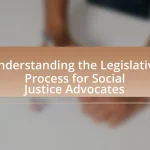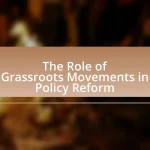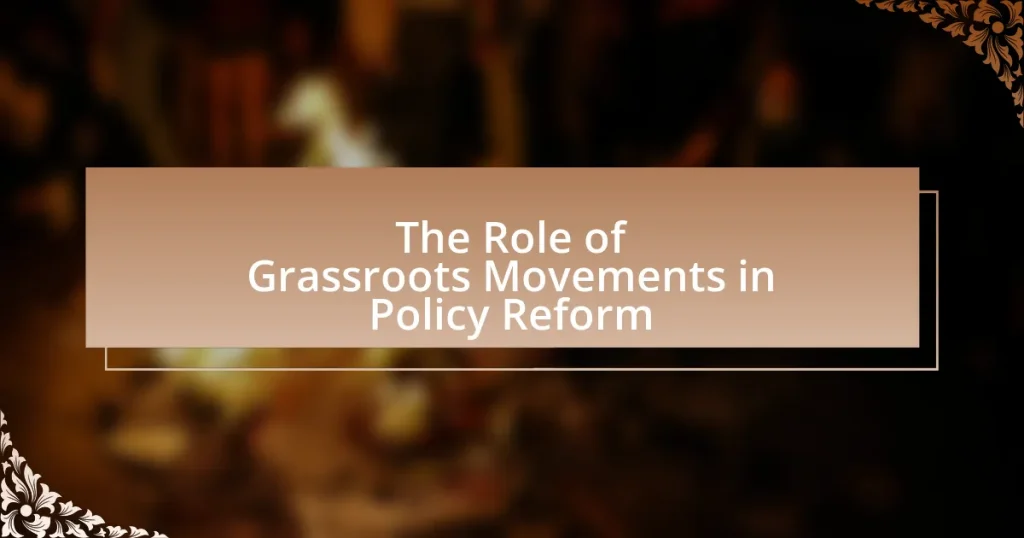Grassroots movements are organized efforts by ordinary individuals at the community level aimed at advocating for social, political, or environmental change, playing a vital role in policy reform. This article explores how these movements initiate change through community mobilization, effective communication strategies, and coalition-building, while also addressing the challenges they face, such as limited resources and opposition from established interests. Successful examples, including the Civil Rights Movement and environmental advocacy, illustrate the significant impact grassroots initiatives can have on policy changes. Additionally, the article highlights the importance of social media and effective leadership in enhancing grassroots efforts and offers practical steps individuals can take to support these movements.
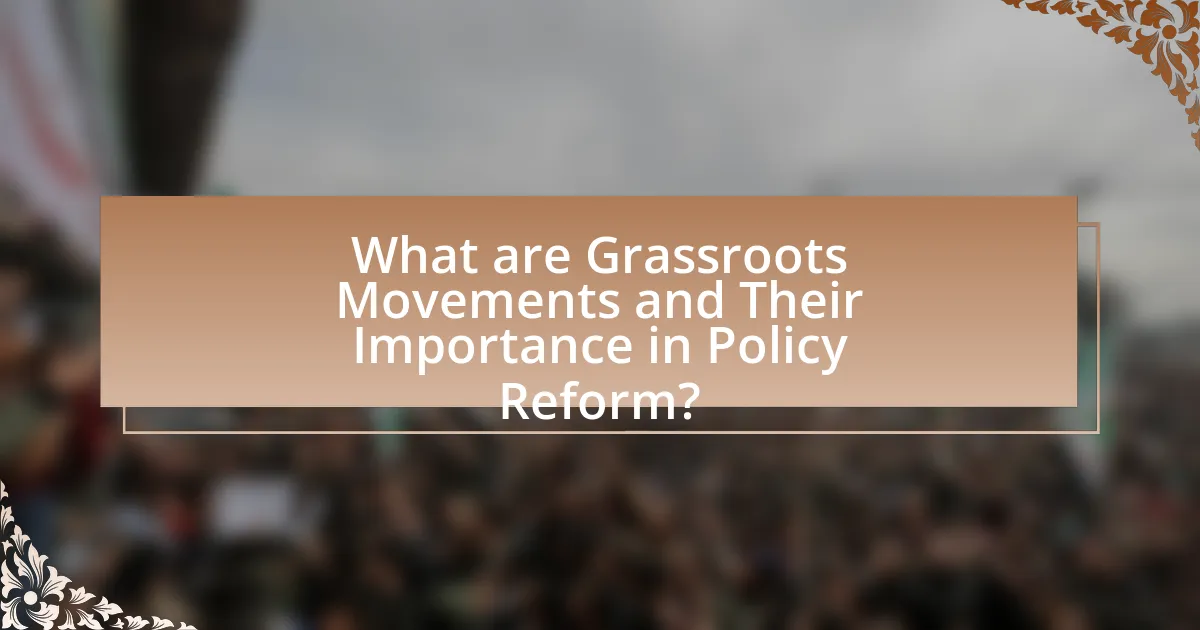
What are Grassroots Movements and Their Importance in Policy Reform?
Grassroots movements are organized efforts by ordinary people at the community level to advocate for social, political, or environmental change. These movements play a crucial role in policy reform by mobilizing public support, raising awareness about specific issues, and influencing decision-makers. For instance, the Civil Rights Movement in the United States effectively utilized grassroots organizing to challenge systemic racism and led to significant legislative changes, such as the Civil Rights Act of 1964. This demonstrates that grassroots movements can create substantial impact by fostering civic engagement and driving policy changes that reflect the needs and desires of the community.
How do grassroots movements initiate change in policy?
Grassroots movements initiate change in policy by mobilizing community members to advocate for specific issues, thereby influencing decision-makers. These movements often utilize strategies such as organizing protests, conducting awareness campaigns, and leveraging social media to amplify their message. For example, the Civil Rights Movement in the United States effectively used grassroots organizing to challenge segregation laws, leading to significant legislative changes like the Civil Rights Act of 1964. This demonstrates that grassroots movements can create substantial pressure on policymakers, ultimately resulting in policy reform.
What strategies do grassroots movements employ to influence policymakers?
Grassroots movements employ strategies such as mobilizing community engagement, leveraging social media, and forming coalitions to influence policymakers. Mobilizing community engagement involves organizing local events, rallies, and town hall meetings to raise awareness and demonstrate public support for specific issues, which can pressure policymakers to take action. Leveraging social media allows grassroots movements to disseminate information rapidly, connect with a broader audience, and create viral campaigns that capture the attention of both the public and decision-makers. Forming coalitions with other organizations amplifies their voice and resources, enabling them to present a united front that can more effectively advocate for policy changes. These strategies have been evidenced in various successful campaigns, such as the Women’s March in 2017, which mobilized millions and influenced discussions on women’s rights and policy reform.
How do grassroots movements mobilize community support?
Grassroots movements mobilize community support by fostering local engagement and building a sense of collective identity among community members. These movements often utilize strategies such as organizing community meetings, leveraging social media platforms for outreach, and creating campaigns that resonate with local issues. For instance, the Black Lives Matter movement effectively mobilized support through social media, which allowed for rapid dissemination of information and coordination of protests, resulting in widespread community involvement and awareness. Additionally, grassroots movements often emphasize personal stories and shared experiences to create emotional connections, which can significantly enhance community solidarity and action.
Why are grassroots movements essential for democratic engagement?
Grassroots movements are essential for democratic engagement because they empower individuals to participate actively in the political process. These movements mobilize communities, amplify marginalized voices, and foster civic participation, which is crucial for a healthy democracy. For instance, the Civil Rights Movement in the United States demonstrated how grassroots organizing can lead to significant policy changes, such as the Voting Rights Act of 1965, which aimed to eliminate racial discrimination in voting. This historical example illustrates that grassroots efforts can effectively challenge systemic injustices and promote inclusive governance, thereby reinforcing the democratic principle of representation.
What role do grassroots movements play in amplifying marginalized voices?
Grassroots movements play a crucial role in amplifying marginalized voices by providing a platform for collective action and advocacy. These movements mobilize individuals from underrepresented communities, enabling them to express their concerns and demands effectively. For instance, the Black Lives Matter movement has successfully highlighted systemic racism and police brutality, leading to widespread public discourse and policy discussions. Research indicates that grassroots organizations can increase political engagement among marginalized groups, as seen in the 2018 midterm elections, where voter turnout among young people of color surged due to grassroots mobilization efforts. This demonstrates that grassroots movements not only elevate marginalized voices but also influence policy reform by fostering greater civic participation and awareness.
How do grassroots movements foster civic participation?
Grassroots movements foster civic participation by mobilizing individuals at the community level to engage in political processes and advocate for social change. These movements create a platform for citizens to voice their concerns, organize collective actions, and influence policy decisions. For instance, the Civil Rights Movement in the United States effectively utilized grassroots organizing to increase voter registration and participation among African Americans, leading to significant legislative changes such as the Voting Rights Act of 1965. This demonstrates that grassroots movements not only empower individuals but also enhance democratic engagement by making political processes more accessible and representative of diverse community interests.
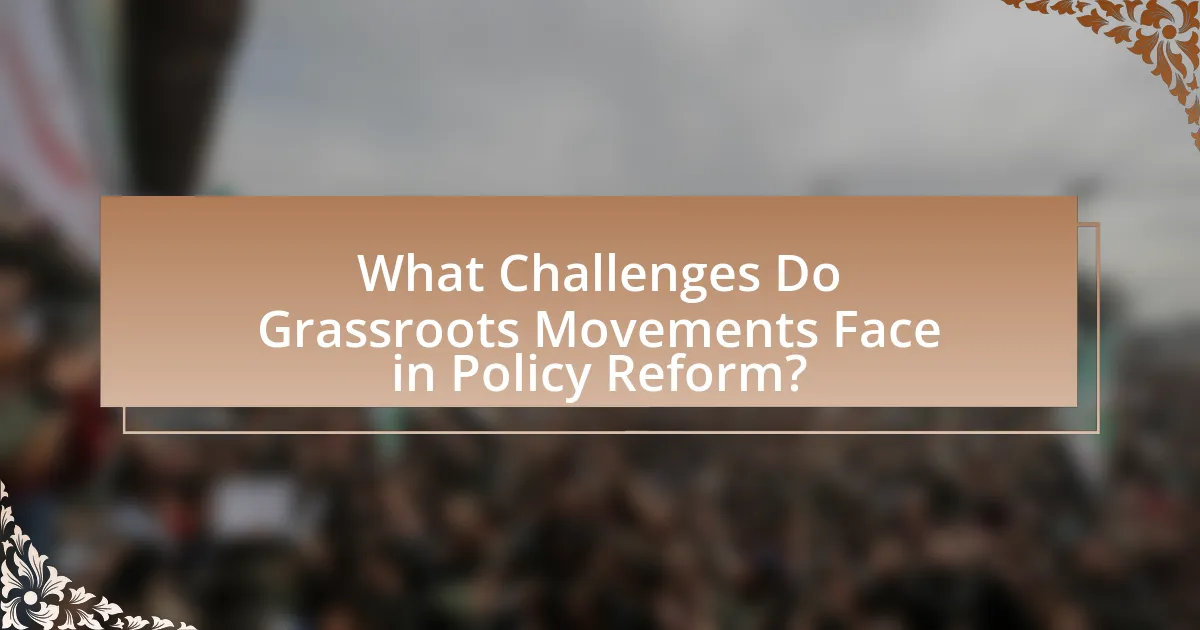
What Challenges Do Grassroots Movements Face in Policy Reform?
Grassroots movements face significant challenges in policy reform, including limited resources, lack of political influence, and opposition from established interests. Limited financial and human resources hinder their ability to mobilize effectively and sustain campaigns. Additionally, grassroots movements often lack the political connections necessary to influence policymakers, making it difficult to gain traction for their proposals. Established interests, such as corporations and political elites, frequently resist reforms that threaten their power or profits, creating further obstacles for grassroots initiatives. These challenges are evident in various historical contexts, such as the civil rights movement, where activists faced systemic opposition despite widespread public support for their goals.
How do funding and resource limitations impact grassroots movements?
Funding and resource limitations significantly hinder grassroots movements by restricting their ability to mobilize, organize, and sustain efforts. These limitations often result in reduced outreach capabilities, making it difficult for movements to engage a broader audience or maintain momentum over time. For instance, a study by the National Committee for Responsive Philanthropy found that grassroots organizations with limited funding often struggle to compete with larger, well-funded entities, which can lead to diminished influence in policy discussions. Additionally, resource constraints can limit access to essential tools such as technology, training, and professional expertise, further impeding the effectiveness of grassroots initiatives.
What are the common funding sources for grassroots initiatives?
Common funding sources for grassroots initiatives include individual donations, crowdfunding platforms, grants from foundations, and corporate sponsorships. Individual donations often provide the backbone of financial support, as many grassroots movements rely on small contributions from community members who believe in their cause. Crowdfunding platforms like GoFundMe and Kickstarter enable grassroots organizations to reach a wider audience and gather funds for specific projects. Additionally, many foundations offer grants specifically aimed at supporting community-driven initiatives, which can significantly bolster funding. Corporate sponsorships can also play a role, as businesses may choose to support grassroots efforts that align with their corporate social responsibility goals. These funding sources collectively empower grassroots movements to drive policy reform and effect change within their communities.
How can grassroots movements overcome resource constraints?
Grassroots movements can overcome resource constraints by leveraging community engagement and strategic partnerships. By mobilizing local volunteers and fostering a sense of ownership among community members, these movements can maximize their impact without significant financial resources. For instance, the 2011 Occupy Wall Street movement utilized social media to organize and spread awareness, demonstrating that effective communication can substitute for monetary resources. Additionally, forming alliances with established organizations can provide access to funding, expertise, and networks, as seen in the collaboration between grassroots environmental groups and larger NGOs during climate advocacy campaigns. These strategies illustrate that grassroots movements can effectively navigate resource limitations through community mobilization and strategic collaboration.
What opposition do grassroots movements encounter from established entities?
Grassroots movements encounter significant opposition from established entities, including government institutions, corporations, and political parties. These established entities often perceive grassroots initiatives as threats to their power and influence, leading to tactics such as lobbying against proposed reforms, discrediting movement leaders, and employing legal challenges to suppress activism. For instance, in the case of the civil rights movement, state governments enacted laws to limit protests and gatherings, demonstrating how established authorities can use legal frameworks to undermine grassroots efforts. Additionally, corporations may engage in public relations campaigns to sway public opinion against grassroots movements, as seen in environmental activism where fossil fuel companies have historically funded campaigns to discredit climate change advocates.
How do political and corporate interests resist grassroots efforts?
Political and corporate interests resist grassroots efforts primarily through lobbying, funding opposition campaigns, and leveraging media influence. Lobbying allows these entities to directly influence policymakers, often resulting in legislation that undermines grassroots initiatives. For instance, the American Petroleum Institute spent over $100 million on lobbying in 2020 to counteract environmental grassroots movements. Additionally, corporate funding can support candidates who oppose grassroots agendas, effectively diminishing their impact. Media influence is also significant; corporations can shape public perception by framing grassroots movements negatively, thereby reducing their support. This multifaceted resistance illustrates the challenges grassroots movements face in enacting policy reform.
What strategies can grassroots movements use to counteract opposition?
Grassroots movements can counteract opposition by employing strategies such as coalition-building, effective communication, and grassroots mobilization. Coalition-building allows these movements to unite with other organizations and stakeholders, amplifying their voice and resources; for instance, the Women’s March in 2017 successfully brought together various groups advocating for women’s rights, creating a larger platform to address opposition. Effective communication involves crafting clear, compelling messages that resonate with the public and counter misinformation; the Black Lives Matter movement has utilized social media to spread awareness and counteract negative narratives surrounding police brutality. Grassroots mobilization engages community members directly, fostering local support and participation, which can be seen in the Fight for $15 campaign that organized fast-food workers to demand higher wages, effectively challenging corporate opposition. These strategies demonstrate how grassroots movements can effectively navigate and counteract opposition in their pursuit of policy reform.
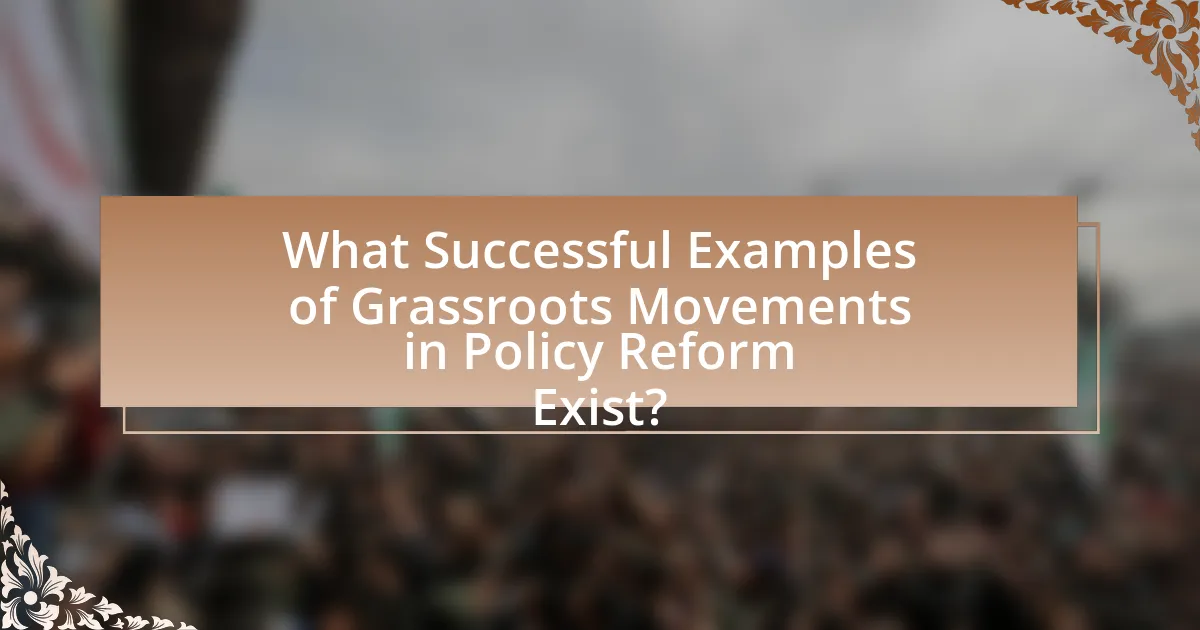
What Successful Examples of Grassroots Movements in Policy Reform Exist?
Successful examples of grassroots movements in policy reform include the Civil Rights Movement in the United States, which led to significant legislative changes such as the Civil Rights Act of 1964 and the Voting Rights Act of 1965. This movement mobilized citizens to advocate for racial equality and justice, resulting in the dismantling of institutional segregation and discrimination. Another notable example is the environmental movement, particularly the grassroots efforts that led to the establishment of Earth Day in 1970 and the subsequent passage of the Clean Air Act and Clean Water Act in the United States. These movements demonstrated the power of collective action in influencing policy and creating lasting change.
How did specific grassroots movements achieve policy changes?
Specific grassroots movements achieved policy changes through organized advocacy, mobilization of community support, and strategic engagement with policymakers. For instance, the Civil Rights Movement in the United States utilized nonviolent protests, legal challenges, and grassroots organizing to dismantle segregation laws, culminating in the Civil Rights Act of 1964. Similarly, the environmental movement, exemplified by the Earth Day initiative in 1970, raised public awareness and pressured legislators to enact the Clean Air Act and the Clean Water Act. These movements demonstrated that collective action and sustained pressure could lead to significant legislative reforms, as evidenced by the passage of landmark laws that addressed systemic injustices and environmental concerns.
What lessons can be learned from the success of the Civil Rights Movement?
The success of the Civil Rights Movement teaches that grassroots activism can effectively drive significant policy reform. This movement demonstrated the power of collective action, as seen in events like the Montgomery Bus Boycott and the March on Washington, which mobilized thousands and garnered national attention. The passage of landmark legislation, such as the Civil Rights Act of 1964 and the Voting Rights Act of 1965, illustrates how sustained advocacy and public pressure can lead to transformative legal changes. Furthermore, the movement highlighted the importance of coalition-building across diverse communities, which strengthened its impact and broadened its reach.
How did environmental grassroots movements influence climate policy?
Environmental grassroots movements significantly influenced climate policy by mobilizing public awareness and advocacy for sustainable practices. These movements, such as the Sierra Club and Greenpeace, have organized campaigns that highlight the urgency of climate change, leading to increased political pressure on lawmakers. For instance, the 2014 People’s Climate March, which drew over 400,000 participants in New York City, demonstrated widespread public support for climate action, prompting governments to prioritize climate policies. Additionally, grassroots initiatives have successfully lobbied for specific legislation, such as the Clean Power Plan in the United States, which aimed to reduce carbon emissions from power plants. This direct engagement has resulted in tangible policy changes and commitments to international agreements like the Paris Accord, showcasing the power of grassroots activism in shaping climate policy.
What are the key factors that contribute to the success of grassroots movements?
The key factors that contribute to the success of grassroots movements include strong community engagement, effective communication strategies, and the ability to mobilize resources. Strong community engagement fosters a sense of ownership and commitment among participants, which is essential for sustained activism. Effective communication strategies, such as social media campaigns and public outreach, help to raise awareness and attract broader support. The ability to mobilize resources, including funding and volunteer efforts, enables grassroots movements to implement their initiatives and influence policy changes. Historical examples, such as the Civil Rights Movement in the United States, demonstrate how these factors can lead to significant social and political reforms.
How does effective leadership impact grassroots movement outcomes?
Effective leadership significantly enhances grassroots movement outcomes by providing direction, motivation, and strategic vision. Leaders in grassroots movements mobilize community members, fostering a sense of shared purpose and commitment, which is crucial for sustaining momentum. For instance, the Civil Rights Movement in the United States, led by figures like Martin Luther King Jr., demonstrated how effective leadership could galvanize public support and drive legislative change, resulting in landmark policies such as the Civil Rights Act of 1964. This historical example illustrates that strong leadership not only organizes efforts but also amplifies the movement’s message, ultimately leading to successful policy reforms.
What role does social media play in the success of grassroots movements?
Social media is crucial for the success of grassroots movements as it facilitates rapid communication, mobilization, and engagement among supporters. By providing platforms for sharing information, grassroots movements can quickly disseminate messages, organize events, and rally support, often leading to increased visibility and participation. For instance, the #BlackLivesMatter movement effectively utilized Twitter and Facebook to raise awareness and coordinate protests, resulting in significant public discourse and policy discussions surrounding racial justice. Studies show that social media can amplify the reach of grassroots campaigns, with a 2018 Pew Research Center report indicating that 69% of adults in the U.S. use social media, making it a powerful tool for grassroots organizations to connect with a broad audience and influence policy reform.
What practical steps can individuals take to support grassroots movements?
Individuals can support grassroots movements by actively participating in local initiatives, volunteering time, and donating resources. Engaging in community events, attending meetings, and spreading awareness through social media amplifies the movement’s message. Research shows that grassroots movements often gain traction through community involvement, as evidenced by the success of movements like Black Lives Matter, which mobilized millions through local actions and online campaigns. Additionally, signing petitions and contacting local representatives can influence policy changes, demonstrating the power of collective action in grassroots efforts.
